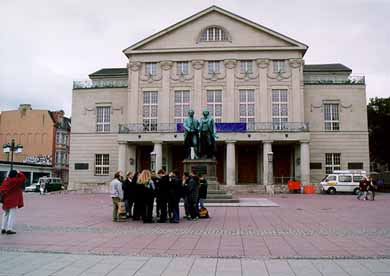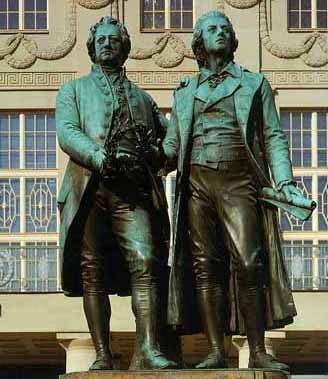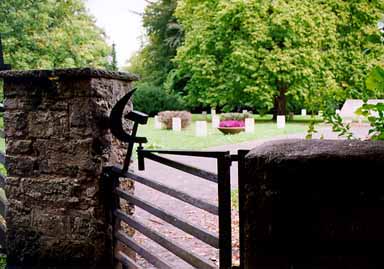National Theater in Weimar For most Americans, the first thing that comes to mind when the city of Weimar, Germany is mentioned is the "Weimar Republic," the name of the democratic government based on the first-ever German constitution, which was written in Weimar after the Social Democrats declared a Republic in a bloodless revolution on Nov. 9, 1918 during the Great War, now known as World War I. The Deutsches Nationaltheater (German National Theater) in Weimar, Germany, shown in the photo above, was where the German National Assembly met to draw up the constitution for the new German Republic. The Weimar constitution was passed a year later on November 8, 1919. The theater was built in 1908 and the first performance was held there on November 1, 1908. During World War II, the building was used as an armament factory, beginning in 1944. To Americans, the Weimar Republic represents a great achievement, since from the American point of view, the Great War was fought "to make the world safe for democracy." As it turned out, the Weimar Republic of the Social Democrats was opposed by many factions of the German people, and was doomed from the start. Before the new government could meet to begin work on the constitution, the Communists, under the Jewish leaders Karl Liebknecht and Rosa Luxembourg, had declared their own Republic in January 1919 but were forced to withdraw when a militia group of 3,000 soldiers, who had returned home after the Armistice of November 11, 1918, defeated them in bloody street fighting in Berlin. The new government considered several cities before selecting Weimar as the ideal quiet place, 150 miles from the capital city, Berlin, where there was still fighting in the streets, as the Communists were trying to oust the Social Democrats. On February 6, 1919, the German National Assembly selected Weimar as the place where the constitution would be written. The fatal flaw in the Weimar constitution was the infamous Article 48, drafted by Social Democrat Max Weber, which gave the Chancellor the right to rule by decree for short periods during a crisis. Soon after he was appointed Chancellor, Hitler invoked Article 48 in order to rule by decree for 7 weeks.  The famous statue of Johann Wolfgang von Goethe and Friedrich von Schiller, Weimar's two great writers of classical literature, was enclosed in a protective casing and escaped damage from the Allied bombing of Weimar on February 2, 1945, which destroyed the building. The building was reconstructed and reopened on February 8, 1948 with a performance of Goethe's Faust, his most famous work. Between 1973 and 1975, the building was remodeled according to a design by architect Richard Paulik. The picture above shows a closeup of the statue which was erected in the square in 1857. Schiller was a favorite of the Nazis, much like Richard Wagner, because he was very patriotic and a German nationalist. His most famous work was William Tell, which extolled Swiss nationalism. Before the unification of the German states in 1871, Schiller was more popular than Goethe, because his writing encouraged German unity. By 1924, barely 5 years after the ink was dry on the constitution, the Nazi party was holding rallies in the National Theater building in a symbolic gesture to show their opposition to the Weimar Republic. The first members of the Nazi party were former soldiers, who had fought in the trenches in the Great War (World War I), and then returned home to fight the Communists in the streets. By 1930 the Nazi party had won enough votes to send their first representative to the National Assembly from Weimar. The Nazi party platform was based on their desire for the unification of all ethnic Germans into one country and for the nullification of the hated Versailles Peace Treaty. The treaty had been signed by the Social Democrats after they forced Kaiser Wilhelm to abdicate his throne, ending 500 years of imperial rule by the Hohenzollern kings. The Nazis blamed the Jewish leaders of the Social Democrats for Germany's defeat in World War I because they had agitated for the end of the war and then signed the Armistice which ended the fighting. The Nazis maintained that the German army had not lost the war on the battlefield because Germany had not been invaded and German soldiers still occupied enemy territory when the fighting ended. German citizens wore lapel buttons that read "Im Felde niemals besiegt." (Never conquered in the field.) The picture below shows a poster which is part of a display about the building. (All the famous buildings in Weimar have booths erected nearby which give information for tourists.) It shows a photograph of the building, draped in Swastika flags, the emblem of the National Socialists (Nazis). Notice that the statue has been covered.  One of the reasons that the Social Democrats chose Weimar as the place for writing the new constitution was that it had long been a mecca for the liberal left. The birthplace of the Social Democrats was in Gotha, twenty miles down the road from Weimar. Directly across from the National Theater where the Weimar constitution was written, stands the Bauhaus museum which commemorates the Bauhaus movement of modern architecture, founded by the liberal leftist Walter Gropius, who opened the Weimar School of Art on April 1, 1919. This new school of architecture taught functional design which was a complete departure from the classic Gothic and Baroque buildings in Germany. Hitler deplored modern art and architecture, which he called "degenerate." In 1925, the Bauhaus architects were forced to leave Weimar because of protests by the right-wing conservatives. As soon as the Nazis gained power in 1933, they closed the Bauhaus school, which had by then been moved to Berlin, another stronghold of the liberal left. The Nazis favored the classic past, as demonstrated by their use of the swastika, an ancient Aryan symbol, which had been used by the Teutonic Knights when they built walled cities in Poland in the 10th century. They were attracted to Weimar because it was famous as the birthplace of Humanism. The founders of German Humanism were Goethe and Schiller, the two literary giants of Germany, whose statue stands in front of the National Theater. Humanism means a return to the past, to the classic art and literature of ancient Greece and Rome. Another famous resident of Weimar was Friedrich Wilhelm Nietzsche, whose philosophy was closely related to the Nazi ideology. Nietzsche, who is most famous to American college students as the man who wrote "God is dead," was also the originator of the "superman" theory which was the basis for the Nazi idea of the Herrenvolk, which Americans translate as "The Master Race." Nietzsche also coined the term "splendid blond beasts" for the Germans. Nietzsche was already completely deranged by the time he moved to Weimar in 1897. After he died there in 1900, his sister, Elizabeth, promoted him as a cult figure in Weimar. Weimar was occupied by the American troops of Patton's Third Army on April 12, 1945, the next day after they had discovered the nearby Buchenwald concentration camp. On July 3, 1945 Weimar and Buchenwald were handed over to the Russians who had been promised Eastern Germany by President Franklin Roosevelt at the Yalta Conference before the war ended. In an insensitive show of their victory in World War II, the Russian Communists buried some of their war dead in a newly created cemetery in Weimar's Park on the Ilm, just across the river from Goethe's famous garden house, which attracts millions of visitors from around the world, and only a stone's throw from the house where Liszt lived. The cemetery has a gate with the Communist red star emblem and a side gate with the Communist hammer and sickle symbol. Now that Weimar is no longer ruled by the Communists, the cemetery is considered out of place in a park that is associated with the beloved Goethe.  Market Square in WeimarGoethe's Home and Garden HouseSchiller's HomeLiszt's HomeFamous buildings in WeimarBauhaus movement in WeimarHomeThis page was last updated on March 23, 2007
|